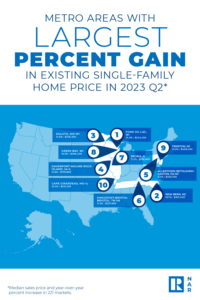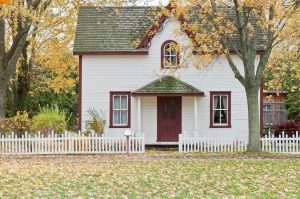 Nearly 60% of major real estate markets tracked by the National Association of Realtors (NAR) (128 of 221 metropolitan areas) showed home price gains in the second quarter of 2023 as the 30-year fixed-rate mortgage could be found for somewhere between 6.28% and 6.71%. Furthermore, 5% of the 221 tracked markets registered double-digit price increases over the same period, but this number is down from 7% in the first quarter of 2023.
Nearly 60% of major real estate markets tracked by the National Association of Realtors (NAR) (128 of 221 metropolitan areas) showed home price gains in the second quarter of 2023 as the 30-year fixed-rate mortgage could be found for somewhere between 6.28% and 6.71%. Furthermore, 5% of the 221 tracked markets registered double-digit price increases over the same period, but this number is down from 7% in the first quarter of 2023.
“Home sales were down due to higher mortgage rates and limited inventory,” said NAR Chief Economist Lawrence Yun. “Affordability challenges are easing due to moderating and, in some cases, falling home prices, while the number of jobs and incomes are increasing.”
Compared to a year ago, the national median single-family existing-home price dipped 2.4% to $402,600. In the prior quarter, the year-over-year national median price decreased 0.2%.
“Just like the weather, large local market variations exist despite the minor change in the national home price,” Yun added.
Among the major regions (Northeast, South, Midwest, West) the south saw the largest share of existing single-family home sales (46%) during the second quarter, with year-over-year price depreciation of 2.2%.
In the Northeast prices rose 3.2%, 1.4% in the Midwest, but fell 5.8% in the West.
Year-over-year prices in the second quarter declined by 19.1% in Austin, 11.3% in San Francisco, 9.6% in Salt Lake City and 7.4% in Las Vegas.
“Interestingly, price declines occurred in some of the fastest job-creating markets,” Yun said. “Prices in these areas are trying to land on better fundamentals after several years of skyrocketing increases. In fact, the number of homes receiving multiple offers, alongside continuing job and wage gains, signal price slides may already be a thing of the past.”
About two in five markets (41%; 90 of 221) experienced home price declines in the second quarter, up from 31% in the first quarter.
According to the NAR, housing affordability worsened from the first-to-second quarter due to rising home prices and mortgage rates; the monthly mortgage payment on a typical existing single-family home, assuming a standard 20% down payment) rose 10% to $2,051 from the first quarter when payments averaged $1,864. Year-over-year payments are up 11.6%, or $214, as families typically spent 27% of the income on mortgage payments, up from 24.5% in the previous quarter and 25.3% year-over-year.
Further, lack of affordable housing and low inventory continued to impact first-time buyers during the second quarter. For a typical starter home valued at $342,200 with a 10% down payment loan, the monthly mortgage payment grew to $2,012, up 9.9% from the previous quarter ($1,830). That was an increase of more than $200, or 11.3%, from one year ago ($1,807). First-time buyers typically spent 40.7% of their family income on mortgage payments, up from 37.1% in the prior quarter.
A family needed a qualifying income of at least $100,000 to afford a 10% down payment mortgage in 40.3% of markets, up from 33% in the prior quarter. Yet, a family needed a qualifying income of less than $50,000 to afford a home in 6.3% of markets, down from 10% in the previous quarter.






